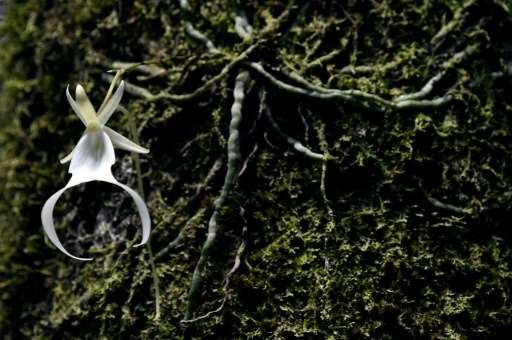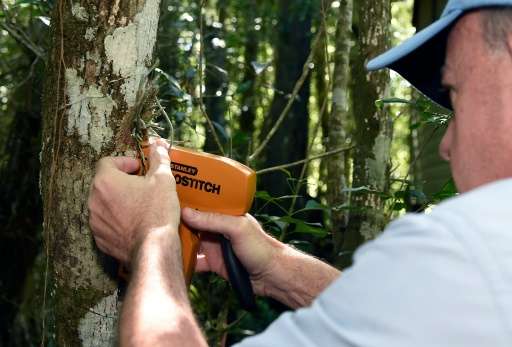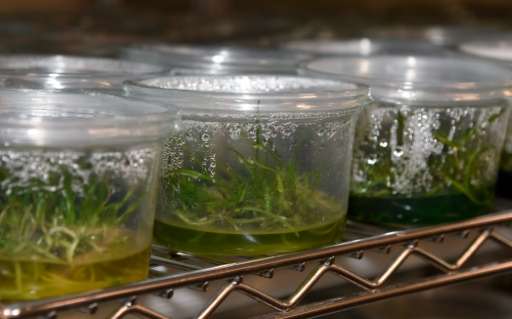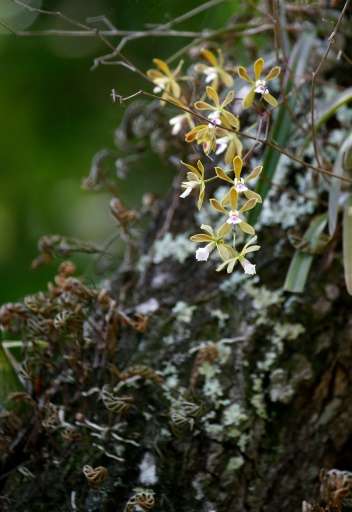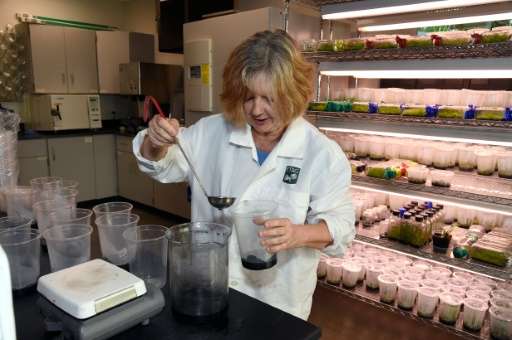Once abundant in the Florida Everglades, experts say fewer than 2,000 ghost orchids (Dendrophylax lindenii) are left in the state, where it is considered an endangered plant
Armed with an orange staple gun and dozens of burlap squares entwined with ratty green roots, Mike Kane wades hip-deep into the swamp to restore what generations of thieves have stolen.
The ghost orchid.
Once abundant in the Florida Everglades, experts say fewer than 2,000 ghost orchids (Dendrophylax lindenii) are left in the state, where it is considered an endangered plant. Cuba has some too, but just how many is unknown.
Poaching, urbanization and pesticide pollution—which cuts down on insect pollinators—are among the ghost orchid's top threats, according to Kane, a professor of environmental horticulture at the University of Florida.
"We are losing these," said Kane, who is leading the first project of its kind to repopulate the swamps with these orchids.
He and his graduate students grow ghost orchids from genetically diverse seeds in their northern Florida lab.
After the plants have grown for a few years, they take them to a secluded location deep inside the Florida Panther National Wildlife Refuge in the southern part of the state.
This tranquil spot, known as McBride's Pond, lies under a shady canopy of pop ash, pond apple and cypress trees.
"The public cannot come in and poach and they cannot disrupt our experiments," said Jameson Coopman, a graduate student in Kane's lab.
Dr Michael Kane, Environmental Horticulturist at the University of Florida, attaches an endangered ghost orchid to a host tree at the Florida Panther National Wildlife Refuge in Immokalee
The two men take turns stapling the burlap—not the roots—onto the tree trunks, as an alligator quietly suns itself nearby and swallowtail butterflies swoop overhead.
The burlap will decompose, but the orchid's spider-like roots will hug the bark and hopefully, make the tree its new home.
"We give it a quick mist when we are done," said Coopman.
"We don't help the plant any further and it does the rest."
This year, they planted 160.
Last year, it was 80. Kane recalled high-fiving in the swamp with his then graduate student, Nguyen Hoang of Vietnam, when they returned a few weeks after planting and discovered that most had survived.
"They were doing so well. It was incredible. We were really surprised."
Kane's lab has also seen some unusual success with botanists managing to coax ghost orchids to bloom in the space of three years. In the wild, they can take 16 years or more, if they ever flower at all.
Scientists and researchers have been growing the orchids, native to Florida and Cuba, in labs with hopes of reintroducing the endangered species into the wild
Target for thieves
The ghost orchid, often targeted by poachers, rose to pop culture fame with the book, "The Orchid Thief," and its movie version, "Adaptation," starring Nicolas Cage and Meryl Streep.
Orchid enthusiasts are romanced by the leafless flower's erotic appearance, its pure white hue, and the way it dances in the wind.
The bloom emerges just once a year, usually for a week or so in June or July.
It has one known pollinator, the giant sphinx moth.
The ghost orchid is tough to grow and even tougher to keep alive, especially when ripped from its natural environment.
"The reason they are almost extinct is that years ago, people took them out of the forest, they took them down from the trees and sent them around to other parts of the country to grow as houseplants," said Carl Lewis, director of the Fairchild Tropical Botanical Garden in Miami.
Lewis is leading another restoration effort known as the Million Orchid Project.
The five-year plan aims to re-establish eight different kinds of rare orchids, including the ghost orchid, throughout urban spaces in south Florida.
The native Florida Butterfly Orchid blooms on the grounds at Fairchild Tropical Gardens in Miami
"There were so many of them taken away that now we have hardly any of them left," said Lewis, who is cloning ghost orchids in his lab.
"Imagine if we could get these orchids growing in the tree canopy above a busy, functioning city," he added.
"Our goal is to get so many out in the community that people will just appreciate them, and anyone interested in stealing them will have so many orchids around that there will be no point."
Future threats
Elsewhere in the Florida Everglades, biologist Mike Owen keeps close tabs on 120 of the 380 ghost orchids that have been observed in the Fakahatchee Strand Preserve State Park.
He says he likes them because they are the "underdogs" of the flower world, like Cinderella, whose time at the ball was so fleeting, or the bug-eyed American comedian Rodney Dangerfield, who was popular in the 1980s.
"It just gets no respect," Owen said with a grin, echoing Dangerfield's signature punchline.
"But then for about 10 days, it steals the show."
In the past 15 years, Owen has noticed nine were stolen. Add that to another two dozen or so that died of apparently natural causes, and he sees trouble ahead for this fragile flower.
Susan Thomas, volunteer at the Fairchild Tropical Botanical Garden, prepares containers for the Florida Butterfly Orchid at a lab in Miami
"If you take a ghost orchid out of its native habitat, it will die," said Owen.
"And people know this. But somebody must be offering some money for a ghost orchid flower."
Owen and his colleagues are compiling a list of all the known ghost orchids in the region. Perhaps one day, this data will support a petition to get federal endangered species protection for the ghost orchid, he said.
"Then, the laws are a lot tighter. The fines are a lot larger too."
Owen is also concerned about an Asian pest known as the emerald ash borer which is spreading in the United States, and might someday make it to south Florida.
"It kills all the ash trees," including the type that ghost orchids prefer as their hosts, known as pop ash, said Owen.
"If we lose the pop ash, we are going to lose about 80 percent of our ghost orchids."
Scientists who seek to preserve this rare orchid say it's about more than just a flower.
"Orchids are the first line indicators of environmental change," said Kane.
"Understanding how they grow, how to reintroduce them, is a very important foundation for conservation."
© 2016 AFP
